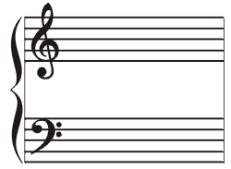Piano Online Lesson: Play Fur Elise – Lesson 1
How to Play Fur Elise – Lesson 1
Hello everyone.
It’s time to get started learning how to play Fur Elise on the piano.
More specifically, today you will learn how to play a large portion of the first movement of Fur Elise.
If you have forgotten what I mean by a movement, you can review this information in last week’s blog post: Piano Online Performance: Fur Elise.
Remember that you can learn to play the piano just by watching my videos, but for those of you that want to take things to a more advanced level, please continue reading after the video.
Note that the video starts by showing the part that I will be teaching. After that I will teach you how to play this part note by note.
Make sure you take your time as you go through this video. You do not have to go through the whole video in one day. If you spend just five minutes a day following this video, then by next week you will have mastered this part, and you will be ready for lesson 2.
Make sure to rewind frequently – try to get comfortable with each part before moving on.
Okay that’s enough reading…let’s start watching, and learning how to play Fur Elise:
Some Basic Theory:
Now, for those of you that want to take things to a more advanced level, let’s get a little deeper into the theory.
Some of you may even want to purchase a copy of the sheet music for Fur Elise.
For example, you can purchase it using the following link: Fur Elise sheet music
Once again, before you click on the link above, please note that it is an affiliate link. So if you make a purchase after using this link, I get a small commission from the seller. If you really like me use the link. If you only like me a little, maybe give it another week – I’m an acquired taste…
Anyway, let’s take a look at a transcription of the part of Fur Elise taught in this lesson.
And now let’s learn about the various components from this transcription.
The Grand Staff
In a standard piece of written piano music there will be two staves connected by a brace. A stave (or staff) consists of five horizontal lines and four spaces, each corresponding to a different note on the piano. The top staff is called the treble staff and the bottom staff is called the bass staff. The brace indicates that a single performer is to play both staves simultaneously. On each staff you can find a symbol called a clef. In piano music two different clefs are used – a treble clef appears on the treble staff and a bass clef appears on the bass staff.
See if you can identify the treble staff, bass staff, treble clef, bass clef, and brace in the following picture:
So what is the purpose of labeling each staff with a different clef? Well the clef determines how each line and space on the staff corresponds to a key on the piano. For example, the treble clef tells you that the topmost horizontal line corresponds to an F on the piano, whereas the bass clef assigns the topmost horizontal line to a much lower A.
Time Signature
Now let’s talk about the time signature. In Fur Elise the time signature is 3/8 as we can see by the following symbol which is placed right next to the first treble clef and first bass clef in the first line of music:
This time signature indicates that there are three eighth notes per measure. Each measure is separated by two barlines. Note that in the transcription of Fur Elise above the first measure is incomplete. This is followed by three complete measures.
Notes
So you may be wondering what an eighth note looks like. Well an eighth note is drawn in two different ways, depending upon if there is only one, or more than one in a row. Here is what it looks like:
If you take another look at the transcription of Fur Elise above, you will see that there is an eighth note on the treble staff right at the beginning of the third measure.
Note that most of the notes shown in the transcription are not eighth notes. They are actually sixteenth notes. Sixteenth notes look like this:
Dynamics
One last thing for today. Let’s talk about what that “double p” means right at the beginning of the transcription. I’m talking about this symbol:
This is an abbreviation for the word pianissimo which means “very soft.” So the transcriber of this version of the piece would like you to play this part of this movement very softly.
Well that’s all for today. If you’re concerned that we didn’t cover every symbol that appears in the transcription above, don’t be! We are not finished discussing this.
There will be plenty more information next week…
~ Steve





